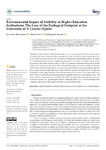Environmental Impact of Mobility in Higher-Education Institutions: The Case of the Ecological Footprint at the University of A Coruña (Spain)

View/
Use this link to cite
http://hdl.handle.net/2183/28483Collections
- Investigación (ETSECCP) [826]
Metadata
Show full item recordTitle
Environmental Impact of Mobility in Higher-Education Institutions: The Case of the Ecological Footprint at the University of A Coruña (Spain)Date
2021Citation
Perez-Lopez, J.-B.; Orro, A.; Novales, M. Environmental Impact of Mobility in Higher-Education Institutions: The Case of the Ecological Footprint at the University of A Coruña (Spain). Sustainability. 2021, 13(11), 6190. https://doi.org/10.3390/su13116190
Abstract
[Abstract] Ecological footprint (EF) determines the area of ecologically productive territory necessary to produce the resources utilised and to assimilate the waste produced by a given population over a year. Knowing your own EF is the first step in planning and implementing policies to reduce it. Considering that transport is a significant component of the impact of human activity on the environment, this study calculates the EF of the CO2 emissions associated with person mobility (EFM) at the University of A Coruña (UDC). The results presented are based on statistical inference from surveys conducted in 2008, 2016, and 2020. The period 2008–2016 coincides with the effects of the economic crisis, and 2020 with those of the COVID-19 pandemic. The EFM of UDC in 2016 was 2177 global hectares (gha), 148 times its biocapacity. Ninety-two percent of it was generated by car trips. Policies to reduce the environmental impact of mobility should focus on reducing car use. This study analyzes various factors of variability. The EFM per capita of the commutes from the place of residence to the UDC campuses grew between 2008 and 2020 by 17%. The results obtained are compared with those of other nearby universities and around the world.
Keywords
Ecological footprint of mobility
Higher education
Survey
Inference
Environmental impact
Higher education
Survey
Inference
Environmental impact
Editor version
Rights
Atribución 4.0 Internacional






